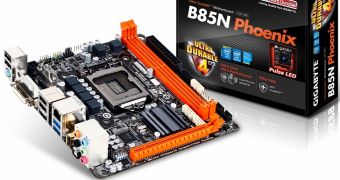Miniature personal computers need equally miniaturized hardware, but none are more important than the motherboard, whose size and feature set ultimately determines pretty much everything. Gigabyte has just launched a mini-ITX platform powered by the N85 Intel chipset.
Intel B85 is one of the chipsets used for current-generation Core-series, Pentium and Celeron central processing units based on the Haswell micro-architecture.
It's the entry-level chipset to be precise, bereft of any overclocking features, or anything that could let it power high-end computers really.
Still, it covers all the bases, and then some, which means that the Gigabyte B85N-Phoenix motherboard is somewhat richer in features than others of its kind.
Which is to say, while the core spec sheet is more or less normal, the connectivity capabilities are significant and varied.
There is dual-link DVI support, an HDMI output, 8-channel HD audio with optical TOSLINK output, a PS/2 connector (for mouse or keyboard), Gigabit Ethernet, two USB 3.0 ports on the back panel (two more via headers,) and two USB 2.0 ports (plus some more via headers).
That said, the storage support isn't too shabby either, with three SATA 6.0 Gbps ports and one SATA 3.0 Gbps connector. In other words, three SATA III ports and one SATA II port, respectively.
Furthermore, there is a PCI Express 3.0 x16 slot, along with a mini PCI Express 2.0 slot. The latter will probably be populated by a wireless card, with Wi-Fi and Bluetooth.
After all, the Gigabyte B85N-Phoenix mini-ITX motherboard has holes for two antennae, but does not ship with an add-in board like others of its kind.
As for memory, the CPU socket is wired to two DDR3 DIMM slots (full-size DRAM slots as it were), enabling up to 32 GB in a single system (dual-channel).
Everything gets power from a 24-pin ATX and a 4-pin CPU power connector. The electricity is distributed through a 4+2 phase VRM (voltage regulation module).
Gigabyte didn't announce a price, unfortunately. It also didn't exactly explain why the B85N-Phoenix mini-ITX motherboard has a black and orange color theme similar to the one normally used by high-end, overclocking-prone platforms. It's not like the feature set is all that astonishing, minus the connectivity front, and there is no OC support at all.
Then again, maybe that's precisely why Gigabyte went with black and orange, instead of blue or green. The motherboard doesn't stand out in any other way, really, unless the price turns out to be particularly enticing. So an unusual coloring was the only way to go in order to grab attention.

 14 DAY TRIAL //
14 DAY TRIAL //